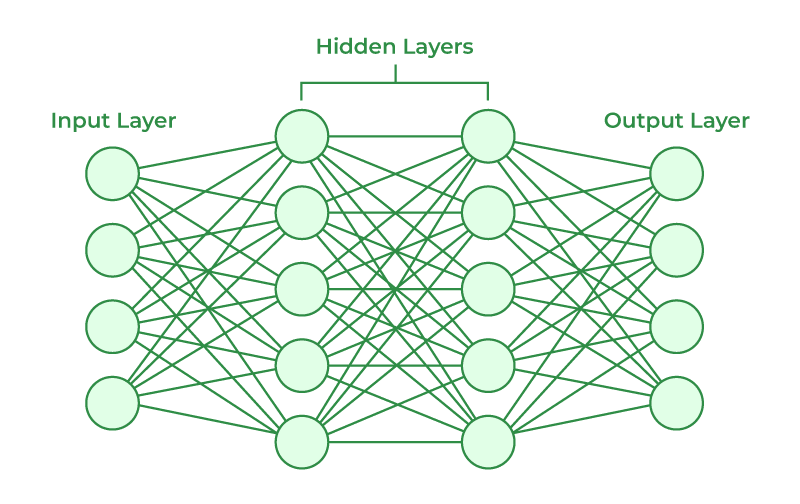Neural Networks in Artificial Intelligence
Artificial Intelligence (AI) has rapidly evolved in recent years, bringing about transformative changes across various industries. At the heart of this evolution lies the concept of neural networks. Inspired by the human brain, neural networks are a class of machine learning algorithms that have significantly contributed to AI’s ability to solve complex problems.
Artificial Neural Networks
Artificial Neural Networks contain artificial neurons which are called units . These units are arranged in a series of layers that together constitute the whole Artificial Neural Network in a system. A layer can have only a dozen units or millions of units as this depends on how the complex neural networks will be required to learn the hidden patterns in the dataset. Commonly, Artificial Neural Network has an input layer, an output layer as well as hidden layers. The input layer receives data from the outside world which the neural network needs to analyze or learn about. Then this data passes through one or multiple hidden layers that transform the input into data that is valuable for the output layer. Finally, the output layer provides an output in the form of a response of the Artificial Neural Networks to input data provided.
A typical neural network consists of three main layers:
- Input Layer: The input layer receives raw data (such as images or text) and passes it to the next layer.
- Hidden Layers: These intermediate layers process the input data using weighted connections and activation functions.
- Output Layer: The final layer provides the result based on the processed data.

Artificial Neural Networks (ANNs) can be categorized based on their architecture, learning methods, and application areas :
- Feedforward Neural Network (FNN) is a type of artificial neural network where connections between the nodes do not form a cycle. Information moves in one direction—forward—from the input layer through hidden layers (if any) to the output layer. There are no loops or feedback connections. FNNs are commonly used for classification and regression tasks. They are the simplest type of neural networks and serve as the foundation for more complex architectures. Training is typically done using backpropagation with gradient descent.
- Convolutional Neural Network (CNN) is a type of artificial neural network designed for processing structured grid-like data, such as images. It is widely used in computer vision tasks like image classification, object detection, and facial recognition. CNNs automatically learn patterns from images, making them highly effective for visual recognition tasks.
- Modular Neural Network (MNN) is a type of artificial neural network that consists of multiple independent neural networks (modules) working together to solve a complex problem. Each module processes a specific part of the input data, and their outputs are combined to generate the final result. MNNs enhance efficiency and performance by breaking problems into smaller, manageable parts.
- Radial Basis Function Neural Network (RBFNN) is a type of artificial neural network that uses radial basis functions as activation functions. It is commonly used for function approximation, classification, and time-series prediction. RBFNNs are effective for pattern recognition and interpolation due to their ability to model complex relationships.
- Recurrent Neural Network (RNN) is a type of artificial neural network designed for sequential data processing, such as time series, speech recognition, and natural language processing (NLP). Unlike feedforward networks, RNNs have loops that allow them to maintain memory of previous inputs.
Applications of Artificial Neural Networks (ANNs)
- Social Media – ANNs are used for facial recognition, content personalization, and friend suggestions. They analyze user interactions, preferences, and connections to provide tailored experiences, enhancing social engagement and user satisfaction.
- Marketing & Sales – Personalized recommendations on platforms like Amazon and Netflix are powered by ANNs. They analyze past purchase behavior, browsing history, and user preferences to suggest relevant products or content, boosting sales and customer satisfaction.
- Healthcare – ANNs help in early diagnosis and treatment planning by analyzing medical images, identifying patterns in patient data, and predicting disease progression. They are especially valuable in oncology for detecting cancerous cells and assisting doctors in decision-making.
- Personal Assistants – Virtual assistants like Siri, Alexa, and Google Assistant use ANNs to process voice commands, understand natural language, and respond accurately. By leveraging speech recognition and natural language processing, they offer a personalized user experience.
In conclusion, quantum computing holds immense potential to revolutionize industries, from cryptography and artificial intelligence to drug discovery and climate modeling. Its ability to process complex problems exponentially faster than classical computers could unlock groundbreaking advancements across various fields. However, significant challenges remain, such as overcoming quantum decoherence, error correction, and scalability issues. While it may take time to fully realize the practical applications of quantum computing, ongoing research and development are likely to lead to transformative changes in the near future, shaping a new era of technological innovation.